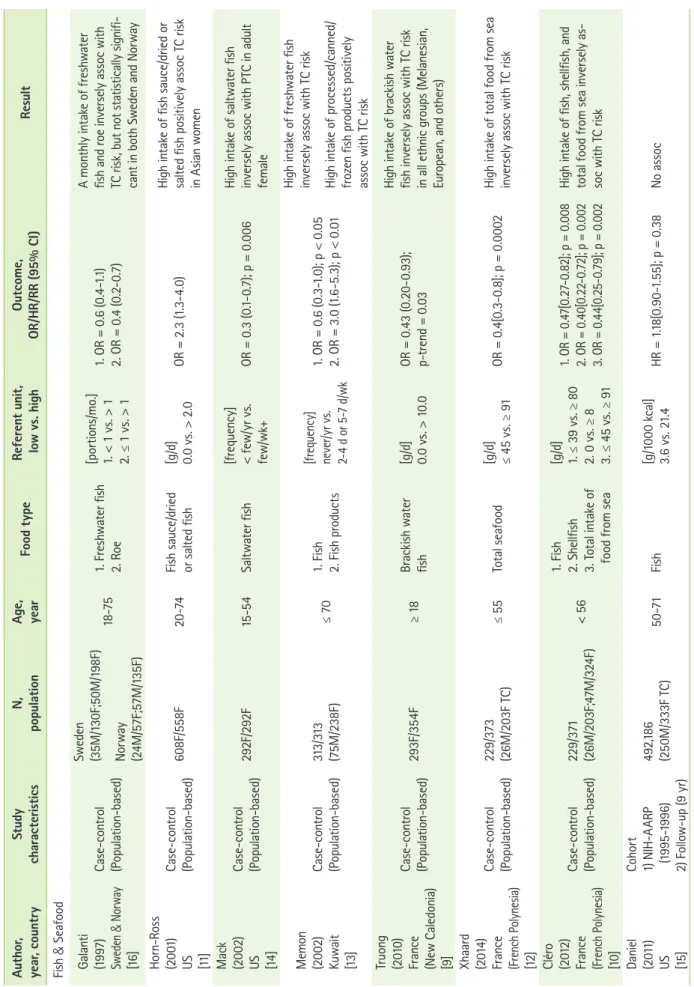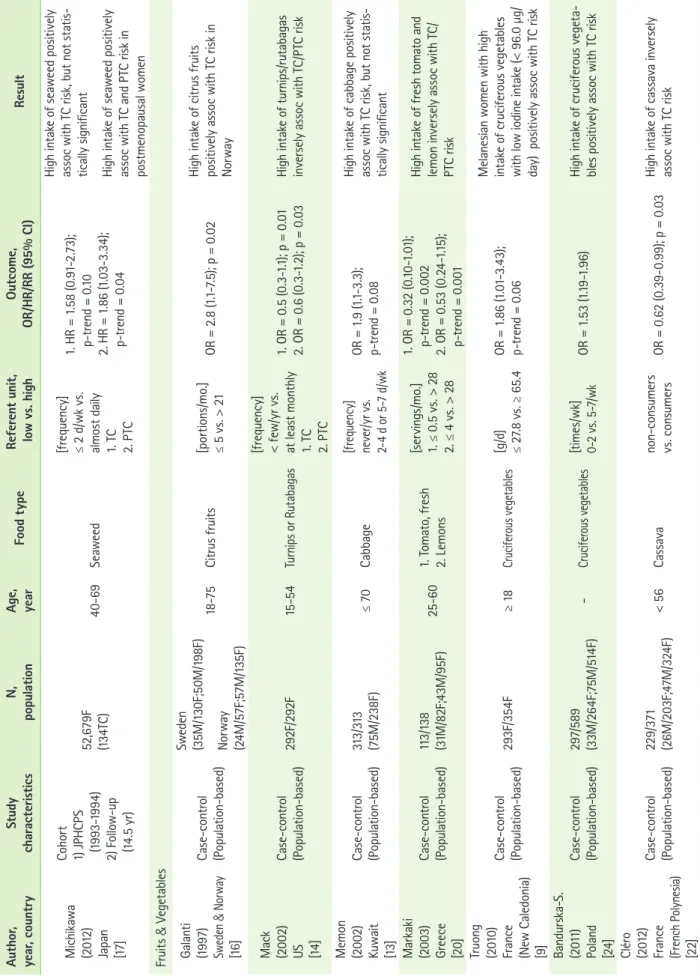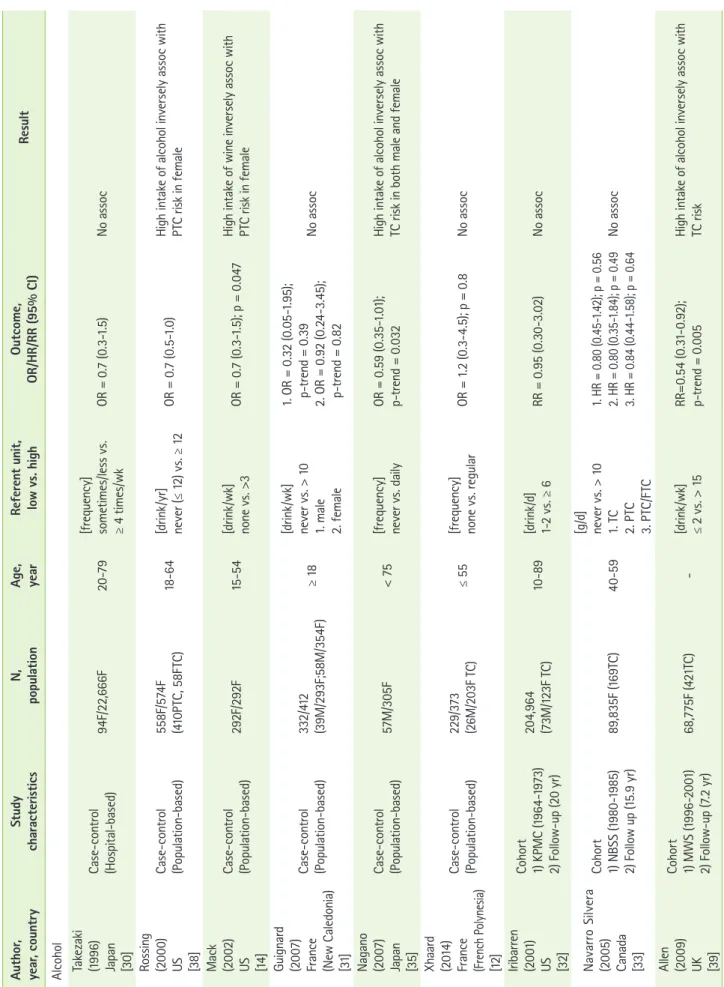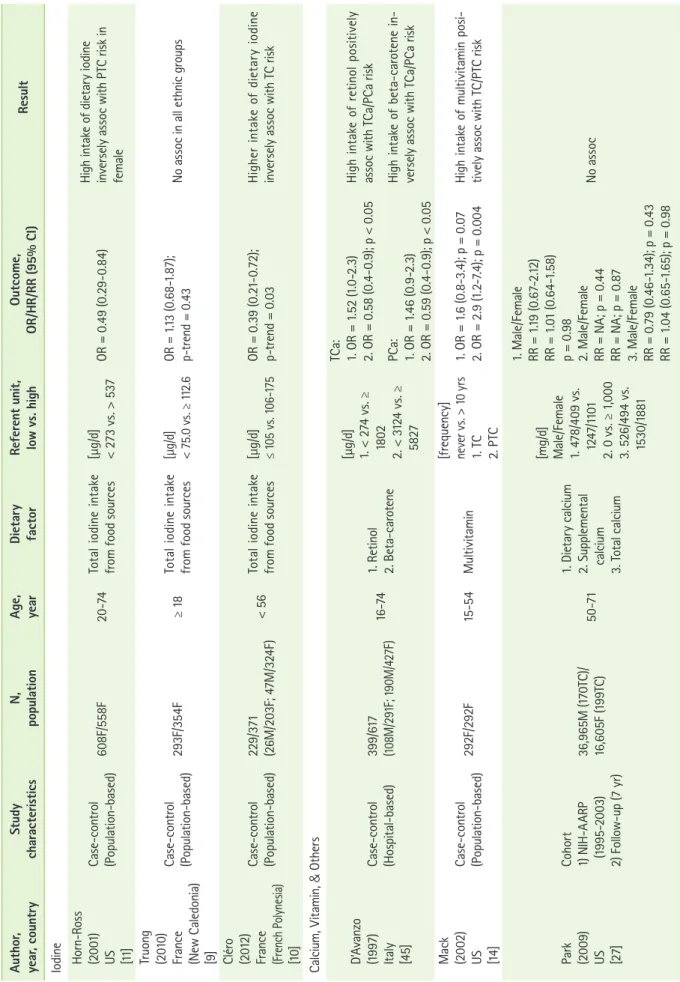Clin Nutr Res 2014;3:75-88
http://dx.doi.org/10.7762/cnr.2014.3.2.75 pISSN 2287-3732 ∙ eISSN 2287-3740
This is an Open Access article distributed under the terms of the Creative Commons Attribution Non-Commercial License (http://creativecommons.org/licenses/by-nc/3.0/) which permits unrestricted non-commercial use, distribution, and reproduction in any medium, provided the original work is properly cited.
© 2014 The Korean Society of Clinical Nutrition
*Corresponding author Jeongseon Kim
Address Molecular Epidemiology Branch, Division of Cancer Epide- miology and Prevention, Research Institute, National Cancer Center, 323 Ilsan-ro, Ilsandong-gu, Goyang 410-769, South Korea
Tel +82-31-920-2570 Fax +82-31-920-2579 E-mail jskim@ncc.re.kr
Funding This work was supported by a grant from National Re- search Foundation of Korea (NRF-2012R1A1A2044332).
Received June 3, 2014 Revised June 19, 2014 Accepted June 20, 2014
Introduction
Thyroid cancer is the most common endocrine cancer, tra- ditionally classified into two major groups based on morpho- logic and clinical features: differentiated carcinoma (papillary, follicular, and medullary) and undifferentiated (anaplastic) carcinoma [1]. The worldwide incidence of thyroid cancer has been rapidly increasing over the last three decades [2]. Papil- lary thyroid cancer accounts for about two-thirds of both male and female cases, while follicular accounts for 10-20%, medullary for 5-10%, and anaplastic for less than 5% [1]. In the U.S., based on the Surveillance, Epidemiology, and End Results (SEER) program between 1992 and 2006, the incidence of papillary thyroid cancer was the highest in Asian females (10.96 per 100,000 woman-years), while papillary and follicular thyroid cancer were the highest among White males (3.58 and 0.58 man-years, respectively) [3]. Since 2004, the incidence of thyroid cancer in the U.S. increased by 5.5% in males and 6.6%
in females [4]. Compared to the U.S., the incidence of thyroid cancer in South Korea was significantly increased from 1999
Dietary Factors and the Risk of Thyroid Cancer: A Review
Wook Jin Choi, Jeongseon Kim*
Molecular Epidemiology Branch, National Cancer Center, Goyang 410-769, South Korea
In the past few decades, the incidence of thyroid cancer has rapidly increased worldwide. Thyroid cancer incidence is relatively high in regions where the population’s daily iodine intake is insufficient. While low dietary iodine has been considered as a risk factor for thyroid cancer development, previous studies found controversial results across different food types. Among differ- ent ethnic groups, dietary factors are influenced by various dietary patterns, eating habits, life-styles, nutrition, and other en- vironmental factors. This review reports the association between dietary factors and thyroid cancer risk among ethnic groups living in different geologic regions. Iodine-rich food such as fish and shellfish may provide a protective role in populations with insufficient daily iodine intake. The consumption of goitrogenic food, such as cruciferous vegetables, showed a positive asso- ciation with risk. While considered to be a risk factor for other cancers, alcohol intake showed a protective role against thyroid cancer. High consumption of meat such as chicken, pork, and poultry showed a positive association with the risk, but dairy products showed no significant association. Regular use of multivitamins and dietary nitrate and nitrite also showed a positive association with thyroid cancer risk. However, the study results are inconsistent and investigations into the mechanism for how dietary factors change thyroid hormone levels and influence thyroid function are required.
Key Words: Thyroid cancer, Dietary factor, Iodine, Food, Review
to 2011 in both sexes [5]. According to the Korea Centers for Disease Control and Prevention (KCDC) in 2012, food products such as processed, agricultural, meats, and marine products were monitored for measuring dietary iodine in Korean popu- lation [6]. Of these food products, dietary iodine from marine products such as seaweed was the highest in Korean adults.
Iodine excess contributes to the changes in thyroid-stimulat- ing hormone (TSH) so that it may increase thyroid cancer risk, particularly in women [7]. Therefore, high intake of iodine from marine products may increase the incidence of thyroid cancer in Korean population.
Environmental carcinogens, such as dietary and nutritional factors, may explain the high incidence of thyroid cancer [8].
Previous studies investigated dietary factors that can possibly affect thyroid cancer risk, but the results were inconsistent due to diverse dietary patterns, eating habits, life-styles, and other environmental risk factors. For instance, multi-ethnic groups living in iodine deficient regions with high intake of seafood showed either no association or lowered thyroid cancer risk [9,10]. Therefore, some ethnic groups exposed to certain food types are at a greater or lower thyroid cancer risk compared with those who are not. The purpose of this study was to review the association between dietary factors and thyroid cancer risk in different ethnic populations in various geologic regions.
Materials and Methods
An article search was conducted in PubMed for studies pub- lished between January 1st 1995 and April 30th 2014. The key- words were as follows: ‘(thyroid cancer) AND (diet OR dietary pattern OR dairy food OR fish OR alcohol OR vegetables)’. The following inclusion criteria were used: 1) epidemiological stud- ies including cases and controls (either hospital or population- based) as well as cohort studies, 2) studies investigating the association between dietary factors and thyroid cancer includ- ing papillary and follicular type, and 3) studies estimating the thyroid cancer risk with odds, relative ratio or hazard ratio (OR, RR, HR) according to dietary factors.
A total of 905 articles were identified through PubMed (Figure.
1). By screening the title and abstract, articles on topics other than thyroid cancer were excluded (n = 795); full-text articles (n = 110) were reviewed for study selection. Of the 110 full- text articles, an additional 85 articles were excluded due to the following factors: 1) reviews (n = 9), 2) studies without epide-
miological research (n = 40), 3) studies without investigating an association between thyroid cancer risk and dietary factors (n = 29), and 4) no case-control or cohort study design (n = 7).
Two additional articles were identified through the references of the original articles and were included in the study. A total of 27 articles (e.g., 17 case-control and 10 cohort studies) were included in this review. Considering geologic regions, there were 12 studies (e.g., 3 case-controls and 9 cohorts) identified from the North America (e.g., U.S and Canada), 10 studies from the Europe (e.g., 9 case-controls and 1 cohort), and 5 studies from Asia (e.g., 5 case-controls).
Results
Fish consumption
Fish and shellfish are the primary source of dietary iodine intake in multiethnic populations [11]. Table 1 describes the as- sociation between the consumption of fish and thyroid cancer risk including 6 case-control studies and 1 cohort study. In French Polynesia, a region with high thyroid cancer incidence due to iodine deficiency in the population, a decreased thyroid cancer risk was associated with high level of fish, shellfish, and total seafood consumption [10]. In the same region, low intake of total seafood was also considered a significant risk factor for the development of thyroid cancer [12]. Similar to French Polynesia, Melanesian women with iodine deficiency in New Caledonia showed no significant association with saltwater fish, seafood, or canned fish; the consumption of brackish water fish, which is exclusively consumed by Melanesians, was inversely associated with risk [9]. A study from Kuwait showed a decreased risk associated with the high intake of freshwater fish, but consumption of processed fish products showed a positive association with development of thyroid cancer [13]. The studies (e.g., 1 cohort and 2 case-controls) from the U.S. found no significant association with fish consumption [11,14,15]. However, a positive association was found with the high intake of fish sauce as well as dried or salted fish in Asian females living in the San Francisco Bay Area [11], whereas frequent intake of saltwater fish decreased papillary thyroid cancer risk in adult females [14]. In Sweden and Norway, no significant association was found with saltwater fish, freshwa- ter fish, shellfish, and fish products [16]. In Japan, a region with exceptionally high seaweed consumption, a positive associa- tion was found between iodine intake via seaweed and thyroid and papillary carcinoma in postmenopausal females [17]. The
study explained that the antiestrogenic bioactive compounds in seaweed did not play a protective role among postmeno- pausal women due to low estrogen and estrogen receptor α (ERα) levels compared with premenopausal women [17].
In previous studies, inconsistent results for the association between fish consumption and thyroid cancer risk were found.
In a pooled-analysis [18], fish consumption was not associated with thyroid cancer risk, but a possible protective role in iodine deficient regions was suggested.
Fruits and vegetables
High intake of fruits and vegetables containing active micro- nutrients (e.g., vitamins and minerals) and phytochemicals pro- vide antioxidant activity that helps to protect against cancers [19]. An individual or combination of bioactive components from fruits and vegetables may provide a protective role in thyroid cancer risk. Table 1 describes the association between the consumption of fruits and vegetables and thyroid cancer risk including 9 case-control studies. In the U.S., the frequent intake of turnips or rutabagas by females was inversely asso- ciated with both thyroid and papillary cancer risk [14,20]. The study from Greece examined the association between dietary patterns and thyroid cancer; the dietary pattern of fruits and raw or mixed vegetables showed a non-significant decreased risk, but particularly, fresh tomato and lemon were signifi- cantly inversely associated with risk [20]. In South Korea, high
levels of raw vegetable and persimmon consumption showed a negative association with both malignant and benign thyroid cancer risk, and tangerine and total vegetable consumption was inversely associated with the risk of malignant and benign thyroid cancer, respectively [21]. This study suggested that a high intake of these fruits and vegetables might help to pre- vent early thyroid cancer. In Norway, a high intake of citrus fruits was positively associated with thyroid cancer risk, but other fruits such as apples and oranges were not associated with an increased risk [16]. In French Polynesia, traditional and Western dietary patterns were compared across 24 goitro- genic food items, and high cassava intake showed an inverse association with thyroid cancer risk [22].
Cruciferous plants (e.g., brussels sprouts and cabbage) con- tain a degraded form of thioglucosides, such as thiocyanates (e.g., goitrogen), and may increase thyroid cancer risk by in- hibiting iodine transport to the thyroid gland at low concen- trations [23]. Four case-control studies found an association between increased thyroid cancer risk and the high cruciferous vegetables intake [9,13,16,24]. The study from New Caledonia among Melanesian women who consume large quantities of cruciferous vegetables and have a low iodine intake (< 96.0 µg/day) showed a positive association [9]. In Sweden, the risk of thyroid cancer associated with a high cruciferous vegetable intake was higher among females who had ever lived in an endemic goiter area [16]. A study from Kuwait showed no clear Figure 1. Flow chart for selection of eligible studies.
Total potential articles identified through Pubmed (n = 905)
∙ Articles screened by title and abstract not relevant to thyroid cancer (n = 795)
Full-text articles reviewed (n = 110) Exclusion (n = 85)
∙ Reviews (n = 9)
∙ No epidemiological study (n = 40)
∙ No association between TC and dietary factors (n = 29)
∙ No case-control/cohort study (n = 7) Full-text articles assessed (n = 25)
Articles in final analysis (n = 27)
∙ Additional articles included (n = 2)
Table 1. The association between fish, fruits and vegetables, meat, and dairy food, and thyroid cancer risk Author, year, countryStudy characteristicsN, populationAge, yearFood typeReferent unit, low vs. highOutcome, OR/HR/RR (95% CI)Result Fish & Seafood Galanti (1997) Sweden & Norway [16]
Case-control (Population-based) Sweden (35M/130F;50M/198F) Norway (24M/57F;57M/135F)
18-751. Freshwater fish 2. Roe [portions/mo.] 1. < 1 vs. > 1 2. ≤ 1 vs. > 1
1. OR = 0.6 (0.4-1.1) 2. OR = 0.4 (0.2-0.7)
A monthly intake of freshwater fish and roe inversely assoc with TC risk, but not statistically signifi- cant in both Sweden and Norway Horn-Ross (2001) US [11]
Case-control (Population-based)608F/558F20-74Fish sauce/dried or salted fish[g/d] 0.0 vs. > 2.0OR = 2.3 (1.3-4.0)High intake of fish sauce/dried or salted fish positively assoc TC risk in Asian women Mack (2002) US [14]
Case-control (Population-based)292F/292F15-54Saltwater fish[frequency] < few/yr vs. few/wk+OR = 0.3 (0.1-0.7); p = 0.006High intake of saltwater fish inversely assoc with PTC in adult female Memon (2002) Kuwait [13]
Case-control (Population-based)313/313 (75M/238F)≤ 701. Fish 2. Fish products [frequency] never/yr vs. 2-4 d or 5-7 d/wk
1. OR = 0.6 (0.3-1.0); p < 0.05 2. OR = 3.0 (1.6-5.3); p < 0.01
High intake of freshwater fish inversely assoc with TC risk High intake of processed/canned/ frozen fish products positively assoc with TC risk Truong (2010) France (New Caledonia) [9]
Case-control (Population-based)293F/354F≥ 18Brackish water fish[g/d] 0.0 vs. > 10.0OR = 0.43 (0.20-0.93); p-trend = 0.03
High intake of brackish water fish inversely assoc with TC risk in all ethnic groups (Melanesian, European, and others) Xhaard (2014) France (French Polynesia) [12]
Case-control (Population-based)229/373 (26M/203F TC)≤ 55Total seafood[g/d] ≤ 45 vs. ≥ 91OR = 0.4[0.3-0.8]; p = 0.0002High intake of total food from sea inversely assoc with TC risk Cléro (2012) France (French Polynesia) [10]
Case-control (Population-based)229/371 (26M/203F;47M/324F)< 56 1. Fish 2. Shellfish 3. Total intake of food from sea [g/d] 1. ≤ 39 vs. ≥ 80 2. 0 vs. ≥ 8 3. ≤ 45 vs. ≥ 91 1. OR = 0.47[0.27-0.82]; p = 0.008 2. OR = 0.40[0.22-0.72]; p = 0.002 3. OR = 0.44[0.25-0.79]; p = 0.002
High intake of fish, shellfish, and total food from sea inversely as- soc with TC risk Daniel (2011) US [15]
Cohort 1) NIH-AARP (1995-1996) 2) Follow-up (9 yr) 492,186 (250M/333F TC)50-71Fish[g/1000 kcal] 3.6 vs. 21.4 HR = 1.18[0.90-1.55]; p = 0.38 No assoc
Table 1. Continued Author, year, countryStudy characteristicsN, populationAge, yearFood typeReferent unit, low vs. highOutcome, OR/HR/RR (95% CI)Result Michikawa (2012) Japan [17]
Cohort 1) JPHCPS (1993-1994) 2) Follow-up (14.5 yr) 52,679F (134TC)40-69Seaweed [frequency] ≤ 2 d/wk vs. almost daily 1. TC 2. PTC
1. HR = 1.58 (0.91-2.73); p-trend = 0.10 2. HR = 1.86 (1.03-3.34); p-trend = 0.04
High intake of seaweed positively assoc with TC risk, but not statis- tically significant High intake of seaweed positively assoc with TC and PTC risk in postmenopausal women Fruits & Vegetables Galanti (1997) Sweden & Norway [16]
Case-control (Population-based) Sweden (35M/130F;50M/198F) Norway (24M/57F;57M/135F)
18-75Citrus fruits[portions/mo.] ≤ 5 vs. > 21OR = 2.8 (1.1-7.5); p = 0.02High intake of citrus fruits positively assoc with TC risk in Norway Mack (2002) US [14]
Case-control (Population-based)292F/292F15-54Turnips or Rutabagas [frequency] < few/yr vs. at least monthly 1. TC 2. PTC
1. OR = 0.5 (0.3-1.1); p = 0.01 2. OR = 0.6 (0.3-1.2); p = 0.03High intake of turnips/rutabagas inversely assoc with TC/PTC risk Memon (2002) Kuwait [13]
Case-control (Population-based)313/313 (75M/238F)≤ 70Cabbage[frequency] never/yr vs. 2-4 d or 5-7 d/wk OR = 1.9 (1.1-3.3); p-trend = 0.08
High intake of cabbage positively assoc with TC risk, but not statis- tically significant Markaki (2003) Greece [20]
Case-control (Population-based)113/138 (31M/82F;43M/95F)25-601. Tomato, fresh 2. Lemons [servings/mo.] 1. ≤ 0.5 vs. > 28 2. ≤ 4 vs. > 28 1. OR = 0.32 (0.10-1.01); p-trend = 0.002 2. OR = 0.53 (0.24-1.15); p-trend = 0.001
High intake of fresh tomato and lemon inversely assoc with TC/ PTC risk Truong (2010) France (New Caledonia) [9]
Case-control (Population-based)293F/354F≥ 18Cruciferous vegetables[g/d] ≤ 27.8 vs. ≥ 65.4 OR = 1.86 (1.01-3.43); p-trend = 0.06
Melanesian women with high intake of cruciferous vegetables with low iodine intake (< 96.0 µg/ day) positively assoc with TC risk Bandurska-S. (2011) Poland [24]
Case-control (Population-based)297/589 (33M/264F;75M/514F) -Cruciferous vegetables[times/wk] 0-2 vs. 5-7/wkOR = 1.53 (1.19-1.96)High intake of cruciferous vegeta- bles positively assoc with TC risk Cléro (2012) France (French Polynesia) [22]
Case-control (Population-based)229/371 (26M/203F;47M/324F)< 56Cassavanon-consumers vs. consumersOR = 0.62 (0.39-0.99); p = 0.03High intake of cassava inversely assoc with TC risk
Table 1. Continued Author, year, countryStudy characteristicsN, populationAge, yearFood typeReferent unit, low vs. highOutcome, OR/HR/RR (95% CI)Result Jung (2013) S. Korea [21]
Case-control (Hospital-based)
Malignant 111F/111F Benign 115F/115F
20-70
1. Malignant 1) Raw vegetables 2) Tangerine 3) Persimmons 2. Benign 1) Raw vegetables 2) Total vegetables 3) Persimmons [g/d] 1. 1) 4.5 vs. 72.5 2) 4.1 vs.79.3 3) 0.0 vs. 24.8 2. 1) 6.0 vs. 77.3 2) 80.8 vs. 422.2 3) 0.0 vs. 24.8
1. 1) OR = 0.20 (0.07-0.62); p = 0.007 2) OR = 0.34 (0.13-0.86); p = 0.027 3) OR = 0.41 (0.17-0.96); p = 0.061 2. 1) OR = 0.28 (0.10-0.76); p = 0.007 2) OR = 0.11 (0.03-0.47); p = 0.003 3) OR = 0.35 (0.15-0.83) ; p = 0.014
High intake of raw vegetables & persimmons inversely assoc with TC malignant and benign risk High intake of tangerine inversely assoc with TC malignant High intake of total vegetables assoc with TC benign Meat Galanti (1997) Sweden & Norway [16]
Case-control (Population-based) Sweden (35M/130F;50M/198F) Norway (24M/57F;57M/135F)
18-75
All Meat - sausages/sausage dishes - pork/beef/lamb - wild (reindeer/elk) - chicken/poultry - liver/kidney - blood pudding/ blood bread - smoked meat
[portions/mo.] ≤ 12 vs. > 20OR = 0.8 (0.5-1.3)No assoc Memon (2002) Kuwait [13]
Case-control (Population-Based) 313/313 (75M/238F)≤ 701. Chicken 2. Mutton & Lamb [frequency] never/yr vs. 2-4 d or 5-7 d/wk
1. OR = 3.0 (1.3-6.8); p < 0.01 2. OR = 1.8 (1.1-2.8); p < 0.01
High intake of chicken or mutton & lamb positively assoc with TC risk Markaki (2003) Greece [20]
Case-control (Population-based)113/138 (31M/82F;43M/95F)25-60Pork[servings/mo.] ≤ 0.5 vs. > 3OR = 2.82 (1.36-5.86); p = 0.001High intake of pork positively as- soc with TC risk in male Daniel (2011) US [15]
Cohort 1) NIH-AARP (1995-1996) 2) Follow-up (9 yr)
492,186 (250M/333F TC)50-71Poultry [g/1000 kcal] 5.3 vs. 51.2HR = 1.74 (1.14-2.67); p = 0.005 High intake of poultry positively assoc with TC risk in male Dairy Food Galanti (1997) Sweden & Norway [16]
Case-control (Population-based) Sweden (35M/130F;50M/198F) Norway (24M/57F;57M/135F)
18-751. Cheese (slice) 2. Butter (tpsn) [portions/mo.] 1. ≤ 40 vs. > 90 2. ≤ 60 vs. > 120
1. OR = 1.5 (1.0-2.4) 2. OR = 1.6 (1.1-2.5) High intake of cheese & butter positively assoc with TC risk in both Sweden and Norway
association with broccoli and Brussels sprout consumption [13]. However, high intake of cabbage showed an increased risk with a borderline significance [13]. No association was found between cruciferous vegetable consumption and thy- roid cancer in the French Polynesians [22]. In Poland, frequent cruciferous vegetable consumption was associated with a 1.5- fold increase in the risk of thyroid carcinoma [24]. A pooled analysis suggested that cruciferous vegetables might provide a protective role that was similar to that of other vegetables for moderate (OR = 0.87 [95% CI = 0.75-1.01]) and for high intake levels (OR = 0.94 [95% CI = 0.80-1.10]) [23].
Meat consumption
While cooking red meat at a high temperature, carcinogenic compounds such as heterocyclic amines (HCA), polycyclic aromatic hydrocarbons (PAH), N-nitroso compounds, or heme iron are formed and carcinogenesis is promoted by increas- ing cell proliferation in the mucosa [25]. Table 1 describes the association between the consumption of meat and thyroid cancer risk including 3 case-control studies and 1 cohort study [13,15,16,20]. The study from Kuwait found a positive association with high intake of chicken or mutton and lamb [13]. Additionally, the studies from Greece and the U.S. found a positive association between thyroid cancer risk and the high intake of pork and poultry [15,20]. No clear association was found between thyroid cancer risk and the consumption of all types of meat in Sweden and Norway [16].
Dairy food consumption
High intake of milk and dairy products was associated with other cancer types such as bladder, prostate, breast, and co- lon cancer risk in multi-ethnic groups in different geological regions [26]. Table 1 describes the association between the consumption of dairy food and thyroid cancer risk including 2 case-control studies and 1 cohort study [9,16,27]. The study from Sweden and Norway found a positive association with the high intake of cheese and butter; particularly, those who had ever lived in an endemic goiter area and had a high intake of all milk products showed a positive association with thyroid cancer risk [16]. However, the studies from the U.S. and New Caledonia found no significant association [9,27].
Alcohol consumption
There is a hypothesis that alcohol intake may increase the level of TSH, which regulates the growth and function of thyroid gland [28]. Based on this hypothesis, elevation of Table 1. Continued Author, year, countryStudy characteristicsN, populationAge, yearFood typeReferent unit, low vs. highOutcome, OR/HR/RR (95% CI)Result Truong (2010) France (New Caledonia) [9]
Case-control (Population-based)293F/354F
[g/d] ≥ (0csoo asN.85 0 =; p9).518.67-13 1 =ORNC.0 v40.6s. ≥ 194.9 Park (2009) US [27]
Cohort 1) NIH-AARP (1995-2003) 2) Follow-up (7 yr) 36,965M (170TC)/ 16,605F (199TC)50-71NC
[servings/100
0
kcal/d] 0.2 vs. 1. 1.4 (male) 2. 1.6 (female) 1. RR = 0.78 (0.45-1.37); p = 0.41 2. RR = 1.04 (0.67-1.62); p = 0.74No assoc TC/PTC: thyroid/papillary thyroid cancer, NIH-AARP: the national institutes of health-american association of retired persons diet and health study, JPHCPS: the japan public health center-based prospective study, No assoc: no association, Assoc: association, M: male, F: female, NC: not classified.





